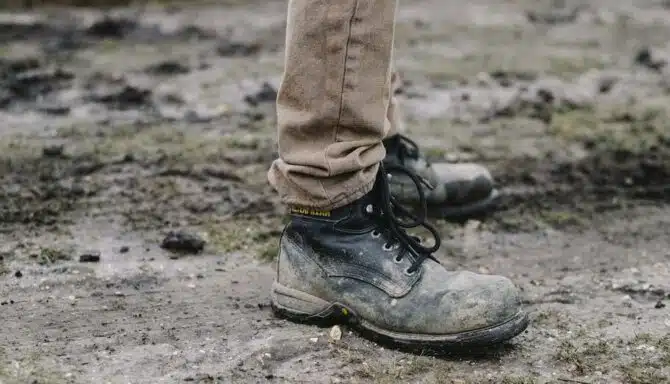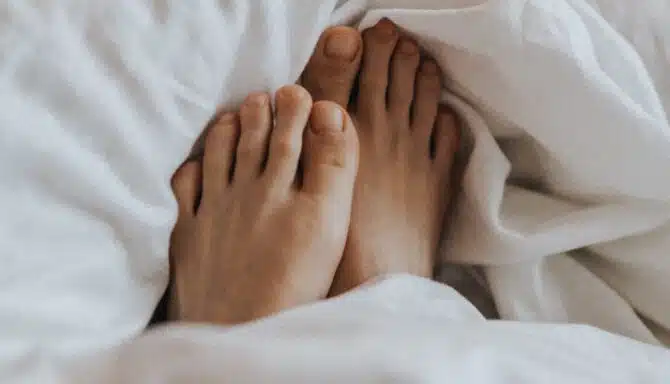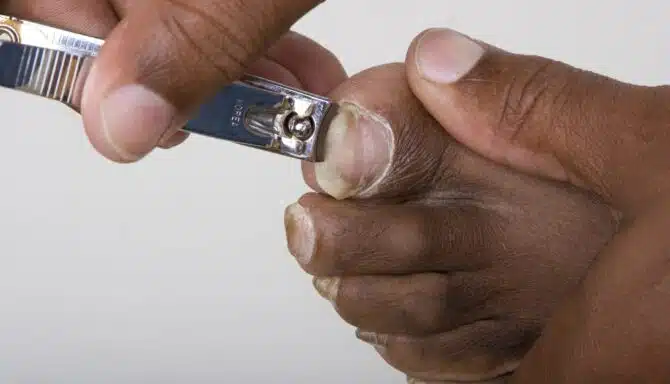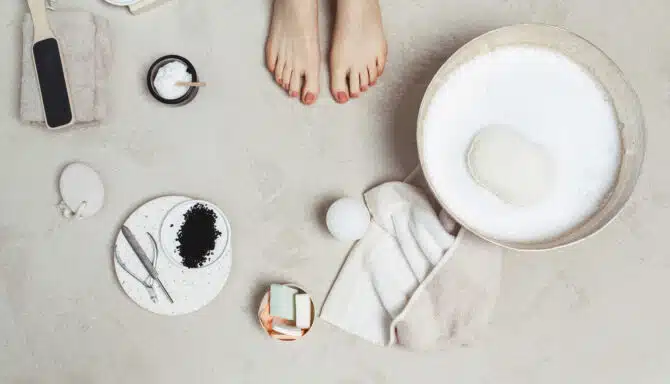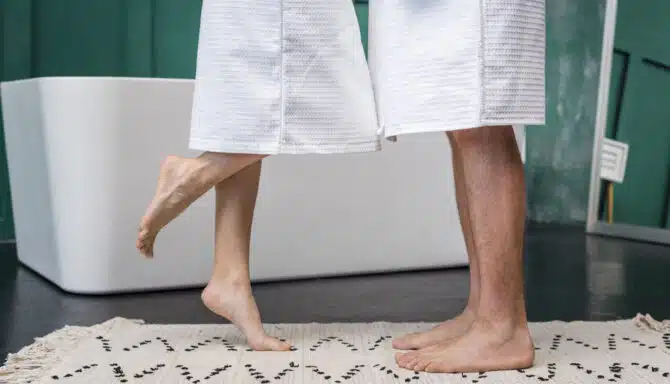June 27, 2024
Construction workers face challenging demands on the job site, including long hours, potential safety hazards, and variable weather conditions. There are few jobs where footwear is more important than on a construction site. Proper footwear is critical for comfort, safety, and overall health.
This blog explores how to find the best shoes for construction workers. We dive into the balance between durability, safety features, and foot health, which are vital for your job.
Durability
Construction sites are full of heavy equipment and sharp objects and tools. Hazards range from sharp objects to heavy machinery. The best shoes and boots for construction workers should be durable, made from leather or synthetic blends, and be able to withstand abrasions and falling objects. Keep your toes and feet safe with toe caps or sturdy outsoles - ideally both.
Refined safety features
Safety is a top priority on the job site. When choosing footwear, opt for models that meet or exceed industry safety standards set forth by the Canadian Centre for Occupational Safety and Health.
Features like steel or composite toe caps provide essential protection against impact and compression injuries, while puncture-resistant midsoles shield your feet from sharp objects on the ground.
Additionally, slip-resistant outsoles help prevent accidents on wet or slippery surfaces, reducing the risk of slips and falls. Refer to the CCOSH's guide for symbols, or markings, on footwear to determine which is appropriate for the job.
Comfort
Long hours spent on your feet can be grueling. It's not uncommon for construction workers to be on their feet for 10+ hours per day. Shop for shoes with adequate support through the arch and heel, and invest in removable insoles or orthotic inserts for even greater support. If you're a construction worker in Toronto, our licensed chiropodists can do a biomechanical assessment to determine the best insoles for your foot condition.
Grip and footing
The type of flooring used in the workplace influences comfort, especially on feet. Unforgiving surfaces like concrete are the least comfortable to work on—your feet and legs absorb all the impact compared to a softer surface. Further, slippery floors (whether smooth or wet) are hazardous for slips and falls. If not careful, you can be exposed to injuries like sprained ankles or broken foot bones.
Fit
Durability and safety features are effective only when your shoes fit the contours and mould of your foot. When trying construction footwear, test out the fit with the same socks and attire you'd be wearing on the job site. If you decide to purchase online, we recommend using the manufacturer's sizing guide for directions, or finding a local retailer to try the shoes on in-store.
June 20, 2024
At first glance, our toenails look like a single nail, and that's about it. However, beneath the surface is a more complex structure that makes up the nail and the bed below it. This is our toenail anatomy.
Toenails and fingernails are made of Keratin. Keratin is a type of protein that gives the nail strength and protection. (There are many types of Keratin. It also comprises hair and your epidermis.) Toenails differ from fingernails in a few ways, namely their thickness and growth rate, as the external forces on your toenails are greater than those on your hands.
Today, we explore toenail anatomy and how each component affects foot health.
Layers of the toenail
Nail plate
The nail plate is the easiest part of the toenail anatomy to recognize. It's the nail itself. The colour and texture of the nail plate can vary based on factors like health, genetics, and lifestyle habits.
Nail bed
Next, we go a bit deeper. The nail bed is beneath the nail plate. Just like sheets and blankets are the nail plate, imagine the nail bed is the mattress or bed frame below. The nail bed is a layer of skin that nourishes the nail as it contains blood vessels and nerves. It is also the growth engine behind the nail plate.
If you damage the nail bed, you'll notice nail plate abnormalities or reduced growth rates. Sometimes, a damaged nail bed will cause you to lose a toenail or experience a discoloured toenail. A subungual hematoma occurs within the nail bed and can cause a black toenail.
Lunula
The lunula, or "half-moon," is the pale, crescent-shaped area visible at the base of the nail. It represents the edge of the nail matrix, where new nail cells are generated. Eventually, nail growth from the lunula extends out to the outer edges of the nail, at which point you'd trim them.
Nail matrix
The nail matrix is the tissue beneath the cuticle at the base of the nail. It produces new nail cells, pushing older cells forward and resulting in nail growth. Damage to the nail matrix can affect the quality and growth rate of the toenail. Each nail matrix produces 196 layers of cells that combine to make your toenails.
June 6, 2024
Our feet and toes change in various ways as we age. One of these changes is toenail thickening.
For some of us, toenail thickening can be more than just a minor inconvenience. It can make it difficult to cut and maintain our toenails, and can even cause pain and discomfort. In this article, we'll explain the causes of thickened toenails, and some possible treatments.
Why Do Toenails Thicken with Age?
Nails are made from a protein called keratin, which is produced at the nail plate at the base of the nail. Nail growth happens when nail cells multiply within the base of the nail and are pushed forward. However, as we age, the growth rate slows down, so the nail cells just pile up on top of each other, which causes them to get increasingly thicker.
Toenail thickening is often a result of several factors:
Reduced blood circulation
The most common cause of toenail thickening is decreased blood circulation to our feet. This diminished circulation means fewer nutrients and oxygen reach the toenails, causing them to thicken over time. Age is one of the risk factor for reduced blood circulation to the feet.
Natural wear and tear
Years of use can damage our toenails. Factors such as ill-fitting shoes, repetitive stress from activities like running or walking, and even minor trauma can contribute to thickening. Essentially, when our toenails experience trauma, they thicken to protect themselves. As we age, wear and tear on our toenails can accumulate, which can cause them to thicken.
Fungal infections
Older individuals are more prone to fungal infections of the toenails, which can cause thickening, discoloration, and brittleness. These infections often thrive in warm, moist environments like sweaty shoes or communal areas.
Underlying health conditions
Medical conditions like psoriasis, diabetes, and peripheral arterial disease can also influence toenail health. These conditions affect circulation, which in turn slows toenail growth and causes toenails to thicken.
Tips for toenail care as you age
As you age, proactive steps can be taken to maintain healthy toenails and minimize thickening. By following these tips, you can feel more in control of your foot health and well-being.
Regular trimming
Toenail thickening can make trimming and maintaining your toenails extremely difficult. Fortunately, a licensed chiropodist is trained to specifically deal with this. A licensed chiropodist can ensure your toenails are trimmed properly to prevent ingrown toenails, promote healthy toenail growth and reduce thickening. A licensed chiropodist can also use special tools over the toenail to thin it out, which will make the toenail easier to cut and maintain. Best of all, this is all done in a sterilized environment, so you don't need to worry about fungal infections (did you know 52% of people get fungal infections after visiting nail salons?) If you decide to trim your toenails at home, make sure you invest in quality toenail clippers and avoid cutting them too short.
Proper foot hygiene
Wash your feet daily with soap and water, ensuring they dry thoroughly, especially between the toes. Also, wear flip flops in public spaces to avoid contracting fungal infections.
Comfortable footwear
Choose shoes that fit well and provide adequate support. Avoid narrow or tight shoes that can put pressure the toenails and contribute to thickening.
Moisturize regularly
Apply moisturizer to your feet to keep the skin and nails hydrated. This can prevent cracking and thickening of the toenails, especially in dry climates.
Foot protection
Wear protective footwear in risky environments like communal areas or outdoors. This can help prevent injury and reduce the risk of fungal infections.
Manage underlying conditions
If you have underlying health issues like diabetes, it's important to remember that they can be effectively managed. By working closely with your healthcare provider, you can improve foot circulation and reduce the risk of complications like toenail thickening.
May 13, 2024
Summer foot care and pedicures - can you name a more iconic duo? Showing off a sleek pedi is one of the best ways to enjoy the warm months. But safe pedicures differ greatly from your run-of-the-mill cosmetic pedicure, so it’s important to be on the lookout for the safest way of avoiding pedicure infections. We’ve got 3 pedicure safety tips you should follow before you hit the salon!
Top 3 Pedicure Safety Tips
Choose clean salons or foot clinics
Avoid certain tools
Practice aftercare
Choose Clean Salons or Foot Clinics
Only visit nail salons that demonstrate good practices. Be on the lookout for:
An organized workspace.
Equipment sanitization protocols. An autoclave with steam sterilization is best.
Employees visibly maintaining hygienic standards.
Employees using disposable liners in the foot baths, and cleaning and filtering them between uses.
Fresh linens (if applicable).
Clean floors and surfaces.
Clean uniforms on employees.
Clear labels on products.
Clients wearing protective footwear when walking around.
Another good tip is visiting your nail salon when they first open in the morning, when everything is cleanest!
Pedicures at Feet First Clinic
Foot clinics are where you can get a medical pedicure, which tends to be safer than a cosmetic pedicure.
Appointments don’t happen in communal areas, unlike salons, so you’re already in a safer environment with less people spreading contagious fungal infections. And although you’ll be skipping the polish (you can always apply it yourself afterwards!) and foot bath (again, you can do this at home - foot baths at nail salons are not hygienic, especially if the bath has jets), you’ll be enjoying so much more than you can get from many salons. This includes:
Guaranteed use of sterilized, safe tools.
A thorough cleaning of the entire foot with alcohol.
An inspection of your feet from a chiropodist who can recognize foot conditions.
Thorough cleaning of dead skin(onychophosis) under the nails.
Callus softening or removal.
Learn more about what happens during a medical pedicure and the differences between a cosmetic vs. a medical pedicure.
Avoid Certain Tools
Nail technicians in salons use many tools, but you should kindly request they skip some of them. One of these is the foot rasp or “grater” they use to scrape the bottom of the feet. It can be overly abrasive and damage the skin, leading to irritation and cuts. Strong skin is a barrier for contaminants, and damaged skin welcomes dirt and infections.
To protect your feet even more, you can skip tools that don’t appear to be properly sanitized or cleaned between uses, or avoid tools with visible signs of wear and tear.
Practice Aftercare
After getting your pedicure, it’s up to you to keep on top of proper foot care! Here’s what to do:
Avoid tight shoes that crowd the toes. This can cause ingrown toenails.
Wash your feet every day with gentle soap before thoroughly drying.
If you must cut your own toenails, only trim straight across, avoiding shaping.
Moisturize and exfoliate your feet.
Wear clean cotton socks and change them frequently.
May 9, 2024
One often overlooked but crucial aspect of personal hygiene is foot care. Your feet carry you through countless activities but don't always receive the attention they deserve when it comes to cleanliness. In this article, we delve into the importance of foot hygiene and tips for keeping feet clean and healthy. From simple daily practices to preventing infections, we’ll explore this aspect of foot health care together.
Wash Your Feet Daily
First thing’s first, lather up your feet! Use mild soap every day to wash your feet either on their own or while in the shower or bath tub. This not only eliminates dirt and keeps your feet feeling fresh, but if you come in contact with tinea pedis soap and water may be able remove the fungus before it becomes athlete’s foot.
Keep Your Feet Dry
If you fail to keep your feet dry you’re welcoming a wide array of issues. Not only does moisture cause foot odour, but it also creates the type of environment foot fungi love and thrive in. It also leads to skin maceration, blisters, cracking, and peeling. Give your feet a good dry with a nice soft towel. Pay extra attention to the hard-to-reach areas in between the toes, and to go the extra mile, let them bask in the air or in front of a fan.
Moisturize Your Feet
Moisturizing hydrates the feet and fights excessively dry skin. When your skin is too dry it can create fissures and cracks that welcome dirt. So, while keeping your feet dry is essential, remember not to overdo it and turn them into the Sahara Desert!
Wear Clean Socks and Rotate Footwear
Keeping your feet cooped up in dirty socks is a recipe for persistent foot odour and moisture. For the ultimate foot refresh while on the go, change your socks throughout the day.
This also applies to your footwear, especially for less breathable shoes. To avoid having to change your footwear all the time, look for light runners and walkers with perforated holes that let fresh air in and out.
Trim Your Toenails
You may be wondering what your toenails have to do with foot hygiene. Trimmed toenails are less likely to harbour dirt and fungus, while also looking great! Jagged edges and too-long nails can also pierce your socks, which ruins their protective purpose. Learn how to trim your nails like a pro here.
Protect Your Feet in Public Areas
Swimming pools, locker rooms, communal showers — you’re putting yourself at risk of contracting a fungal infection if you frequent these places. If you can’t avoid them, protect your feet with shower shoes and flip flops to keep funky fungi at bay!
April 22, 2024
When it comes to anti-aging routines, our feet are often overlooked. Yet, they are one of the hardest-working parts of our body and deserve just as much attention as our skincare regimen.
As we age, our feet undergo natural changes that can lead to discomfort and mobility issues if left unchecked. In this blog post, we'll explore age-defying foot care tips to help keep your feet feeling youthful and vibrant at any age.
1. Maintain proper hygiene
Good foot hygiene is the foundation of age-defying foot care. As we age, our skin becomes thinner and more susceptible to infections, making it essential to keep our feet clean and dry to prevent fungal infections and bacterial growth. Wash your feet daily with soap and water, paying close attention to the spaces between toes, and thoroughly dry them afterward to prevent moisture buildup.
2. Moisturize regularly
Dry, cracked skin is a common issue that affects aging feet. To keep your feet soft and supple:
Moisturize them regularly with a rich foot cream or lotion.
Focus on areas prone to dryness, such as the heels and soles, and consider using products containing ingredients like urea or shea butter, known for their hydrating properties.
For an extra treat, indulge in a weekly foot soak followed by a moisturizing foot mask to pamper your feet and lock in moisture.
3. Supportive footwear
As we age, the fat pads in our feet naturally thin out, leading to decreased cushioning and shock absorption—this is known as fat pad atrophy. Investing in supportive footwear with ample cushioning and arch support is crucial for maintaining foot health and preventing discomfort. Look for shoes with a roomy toe box to accommodate any changes in foot shape, and opt for styles with adjustable straps or laces for a customized fit. Additionally, consider wearing orthotic inserts or custom-made orthotics to provide extra support and cushioning.
4. Consistent exercise
Like the rest of our body, our feet benefit from regular exercise to improve strength, flexibility, and circulation. To keep your feet limber and mobile, incorporate simple foot exercises into your daily routine, such as toe curls, ankle circles, and calf stretches. Additionally, consider practicing yoga or tai chi, which can help improve balance and stability, reducing the risk of falls and injuries as we age.
5. Routine and regular check-ups
Regular foot exams are essential for detecting foot problems or underlying health issues early. Schedule regular check-ups with a chiropodist or foot specialist to monitor your feet's health and address any concerns promptly. They can provide valuable insights and recommendations tailored to your needs, helping you maintain healthy, youthful feet for years.
